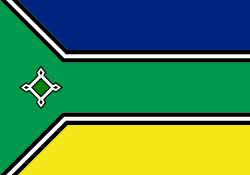Top Qs
Timeline
Chat
Perspective
Flag of Amapá
Brazilian state flag From Wikipedia, the free encyclopedia
Remove ads
The current state flag of Amapá was introduced by Decree No. 8 of 23 April 1984.[1]
This article needs additional citations for verification. (November 2024) |
Remove ads
History
Prior to the creation of the Amapá territory, the area was disputed between France and Brazil. Known variously as the Republic of Counani (1886–1887), and the Free State of Counani (1904–1912), these territories were never internationally recognized, and ultimately quelled by the governments of France and Brazil.[citation needed]
The Federal Territory of Amapá established its own flag, which was used after the state's creation on 5 October 1988, and established by Decree No. 8 of 23 April 1984. However, due to disputes at the time, a tripartite version of the state flag of Pará, showing the fort of São José, was popularly used. This version only ceased to be used during the administration of Aníbal Barcelos.[citation needed]
The flag was chosen by a commission created under Decree No. 4 of 30 January 1984 during the governorship of Aníbal Barcelos.[1]
Remove ads
Symbolism
Each of the flag's colors have specific meanings. The green represents the forests, which make up 90% of the state's territory, as well as hope, the future, love, liberty, and abundance. The yellow represents the federal union and the state's rich soil. The blue represents justice and the sky. The white represents peach, purity, and the desire of its residents to live in harmony with one another.[1] The black stripe represents those who died fighting for the region's independence.[1][2]
The centralized geometric figure on the hoist-side represents the Fortaleza de São José de Macapá.[1][2]
 Flag of the Republic of Counani (1886–1887).
Flag of the Republic of Counani (1886–1887). Flag of the Free State of Counani (1887–1904)
Flag of the Free State of Counani (1887–1904) Flag of the Free State of Counani (1904–1912)
Flag of the Free State of Counani (1904–1912)
Remove ads
References
Wikiwand - on
Seamless Wikipedia browsing. On steroids.
Remove ads






